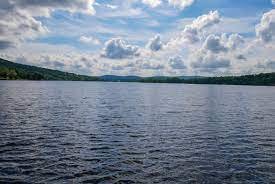Connecticut Student's Research Project Can Impact Future of Lake Waramaug
/Maria Rodriguez-Hernandez, a Western Connecticut State University graduate student enrolled in the Master of Science in Integrative Biological Diversity program, is working to save Lake Waramaug from the infestation of cyanobacteria. She began her research efforts at Lake Waramaug last summer through a part-time summer job and has now expanded it to become part of her pursuit of a master’s degree.
The Master of Science (MS) degree in Integrative Biological Diversity at Western Connecticut in Danbury blends the biological and environmental sciences with current social issues in order to train students to assess, manage, and think critically about biodiversity issues. The Integrative Biological Diversity degree combines graduate courses with faculty expertise. Students have opportunities to collaborate with partnering organizations to engage in real-world practice. The degree program develops environmentally-responsible stewards that can apply scientific thinking to conserve biological resources, manage biodiversity, and address the concerns of stakeholders.
During her internship, Rodriguez-Hernandez managed the zooplankton farm at Lake Waramaug. Zooplankton are tiny animals living in lakes and many feed on algae and cyanobacteria (aka blue-green algae). However, the population of larger zooplankton in Lake Waramaug decreased following the stocking of alewife – a small fish stocked years ago to improve the gamefish population. Without the larger zooplankton to feed on the algae, cyanobacteria levels in the lake are thought to have increased. Rodriguez-Hernandez hopes to help return the zooplankton population to its former state.
“I’m pretty excited to do my thesis,” Rodriguez-Hernandez said. “It has changed the way I see problems with water quality. I’ve always cared about the environment and all the aspects of environmental conservation,” she added, recalling that as a youngster she accompanied her father to see rivers and lakes in her native Wisconsin. She has always felt connected to them and understands how valuable water is.
WCSU Professor of Biology Dr. Theodora Pinou, coordinator of the Integrative Biodiversity program, invited Rodriguez-Hernandez to come to Connecticut to conduct research at Lake Waramaug. She looks forward to seeing the progress of Hernandez’s research efforts.
“She’s great, hardworking, and tries to fund herself,” said Pinou. “She looks for ways to give 100 percent of herself to her research.” Rodriguez-Hernandez’s research project is funded by the highly regarded Lake Waramaug Task Force. Pinou said that Rodriguez-Hernandez “never had an opportunity to have her own project” and the task force gave her the chance to invest her time in it. The task force also is covering her costs to enroll in Limnology studies at WCSU.
In addition, Rodriguez-Hernandez has been awarded a grant from the Connecticut Institute of Water Resources, which will enable her to work with adjunct faculty member Larry Marsicano, a practicing limnologist teaching the Limnology course at WCSU.
Rodriguez-Hernandez’s research has the potential to create solutions that can benefit other lakes as well as saving the human and animal populations.
“Cyanobacteria is a really big issue happening all over the world with marine waters and in lakes,” she explained. “The worst part of the cyanobacteria is that it is in our drinking water. It makes a lot of humans and animals sick.”
Pinou pointed out the strategies for addressing the current situation.
“One way to address this is to find the organism balance and look at developing new ways to address bacterial blooms,” she said, observing that the most concerning aspect of this research is that the bacteria “are not being controlled; they are exploding,” which can be one of the leading causes of climate change. If the cyanobacteria population is not dealt with, there will be underlying effects in the community and possibly around the world.
Lake Waramaug is described as one of the few Heritage Lakes in Connecticut, a designation earned in 2000 that supports the preservation of important environmental features such as water quality, cultural, and scenic aspects. It is the 2nd largest natural lake in the State of Connecticut. The lake contains approximately 6,000,000,000 gallons of water, equal to 6,000 Olympic-sized swimming pools. Lake Waramaug is home to a variety of fish, birds, and woodland animals. In the water, one can find bass, brown trout, and pike, as well as fresh water crayfish, mussels, and snapping turtles.
According to the State Department of Energy and Environmental Protection, Waramaug is the name of an Indian chief of the Wyantenock tribe who had hunting grounds near falls on the Housatonic River, now referred to as "Lover's Leap", in the town of New Milford. Chief Waramaug and his followers wintered in the area now covered by Lake Lillinonah, which was later created by damming the Housatonic, and made Lake Waramaug their summer residence. The land comprising the state park, consisting of approximately 95 acres, was purchased by the State in 1920.
Upper photo: (l-r): Kelsey Sudol, a research assistant with the Lake Waramaug Task Force, with Maria Rodriguez-Hernandez at the lake. Sudol was demonstrating how to use a rake to pull up aquatic plants for identification.































